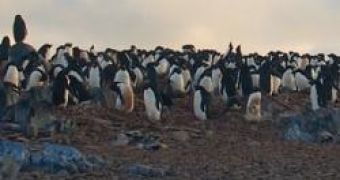Indeed, DDT has been banned in some countries for more than three decades now, but that doesn't mean that several million tons of toxic chemicals just disappeared into thin air during this time. Instead DDT insecticide has been frozen and stored in the Antarctic glaciers, which by the way are now slowly melting away. Although this means that Ad?lie penguins have been exposed to the action of DDT for some time, the concentration of toxin is not high enough to cause any harm.
Marine biologist at Virginia Institute of Marine Science Heidi Geisz who led the team sampling the DDT levels in the penguins, believes that this is yet another clue to the fact that the melting of Antarctic glaciers would release a great deal of the pollutants previously frozen inside. Therefore DDT is not the only toxin we should be worrying about, PCB and PBDE concentrations may also show some increase - both are industrial chemicals capable of causing serious human health problems.
"DDT is not the only chemical that these birds are ingesting and it is certainly not the worst", she said. Dichloro-diphenyl-trichloroethane, or DDT for short, was first created in 1874, but it started being used as an insecticide only about seven decades later, in order to decrease the number of disease carrying mosquitoes. Shortly after, the toxic effects of the chemical were already starting to surface, especially amongst birds of prey that would lay only thin, easily cracked eggs due to high levels of exposure to DDT.
The US banned DDT from use in 1972, being followed by the UK in 1984, and although some countries still use it to combat malaria and dengue the amount used today is 40 times smaller than before the ban. The worldwide use of DDT today is only of 1,000 tons per year. By attaching itself to airborne particles, most of the DDT chemical traveled and settled in the ice sheets of the Antarctic. According to Geisz, the concentrations of DDT in Ad?lie remained stable ever since the survey in 1964, although the logic outcome would have been a decrease in DDT concentrations.
She believes that DDT is somehow included in the birds food chain after which it starts decaying into DDE. DDE is a good indicator to levels of exposure of the birds to the DDT toxin, but her investigations show low concentrations of DDE, meaning that DDT pollution started again, the most likely source being the Arctic glaciers, at a rate of 1 to 4 kilograms of DDT per year.
Environment Canada researcher Derek Muir believes that the Arctic Glaciers could store an even greater amount of the pollutants and DDT exposure to birds should drop. "The declines in DDT in seals and seabirds in the Canadian Arctic and in polar bears in eastern Greenland suggest it is not having a large impact", Muir said.
Further investigations should reveal whether or not the melting of the glaciers is releasing DDT or other chemical pollutants to birds.

 14 DAY TRIAL //
14 DAY TRIAL //